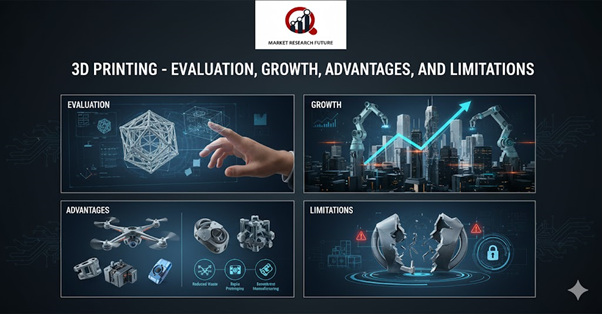3D Printing: Evaluation, Growth, Advantages, and Limitations

With the exponential growth of the 3D printing industry, it is essential to look at why metal 3D printing has been proliferating recently and what we can expect from the 3D printing metals market in the future as more industrial applications emerge.
Metal 3D printing is an additive manufacturing process that uses lasers or electron beams to create a three-dimensional object. The demand for 3D printing services is rising because of increasing customer awareness about its high level of precision and durability.
3D Printing Metal Market Outlook
Owing to wider applications of 3D printing metals in different end-user segments, like the automotive and aerospace industries, the demand for such materials is set to proliferate. The size of the global 3D printing metal market is set to increase from USD 3.09 billion in 2024 to USD 26.79 billion by 2035. This progress is set to occur at a CAGR of 31%.
Metal 3D printing has expanded significantly in recent years because of the rapid development of technology. Numerous creative entrepreneurs and vendors have suggested new, more accessible metal 3D printing technologies and a growing number of compatible materials.
In contrast to conventional production methods, metal 3D printing enables the fabrication of complicated metal parts for a relatively low cost, making it popular across various industries, including the aerospace, automotive, and medical sectors.
Metal 3D printers have undergone a lot of recent advancements. The procedure is more effective than ever, thanks to hybrid systems, metal deposition, recovery materials, and cutting-edge developments.
Reasons for the Growth of the Market
- The primary reason is increased research and development efforts by governments, universities, and private companies. This has made it easier for small companies to get into the business of the 3D printing metals market.
- Secondly, more businesses are turning towards 3D metal printing because less waste is involved in the process, making it a more environmentally friendly choice.
- Lastly, there have been many breakthroughs in metals like titanium that make 3D metal printing accessible to various industries.
Key Trending End-user Industries Driving the 3D Printing Metal Market
- Automotive Industry
The automotive industry will become a significant user of 3D printing metal. Metal additive manufacturing is the most used technology for metal 3D printing and is the most used technology in the automotive industry.
It is easy to see why metal 3D printing will become more and more critical over time. As 3D metal printing becomes increasingly efficient and affordable, it will continue to be an integral part of the production process in many industries.
As cars become more sophisticated, they demand better quality materials that can withstand high temperatures or provide substantial support structures. With 3D metal printing capabilities being so diverse, these demands can easily be met with less energy usage than traditional methods, such as casting or molding would require.
- Aerospace Industry
The aerospace industry has been a driver of 3D metal printing companies, with many manufacturers and research institutes looking for ways to produce lighter and more durable aircraft parts. Airbus is one company that has used 3D metal printing extensively in the production of its aircraft.
For example, it printed an entire titanium wing for its A350 XWB airliner. This allowed them to make 100 major components instead of just five or six, which would have required significant welding and riveting.
General Electric has also successfully 3D-printed fuel nozzles for its new GEnx engine. Other companies such as Toyota, Volvo, and Volkswagen also work on incorporating additive manufacturing into their business models.
- Medical Industry
3D metal printing has been used in the medical industry for over two decades. It is used in various medical fields, including orthopedics and dentistry. It can also be used for surgical planning and training surgeons. This medical use will only grow as 3D printers become more widely available and affordable.
Advantages and Restrictions
Metal 3D printing techniques can be utilized to create intricate, custom items with geometries that are impossible for conventional manufacturing procedures to generate.
It is possible to topologically optimize metal 3D printed parts to increase their performance while reducing their weight and the overall number of components in an assembly.
Excellent physical characteristics and materials that are otherwise challenging to treat, like super metal alloys, are features of metal 3D-printed parts.
Final Thoughts
These technologies are not appropriate for items easily created using conventional techniques due to the high material and manufacturing costs associated with 3D printing metal. The build volume of metal 3D printing systems is constrained due to the need for precise manufacturing conditions and process control.